Singapore is a small island country with a total land area of about 700 sq.km and a population of about 4.8 million. This high population density has led to competition for land that is needed to provide infrastructure for housing, transport, industry as well as water supply. Receiving some 2,400mm of rain each year, Singapore does not lack rainfall for water supply. What it lacks is the limited land resources (i.e. catchment) for storage of water. Bound by this unique circumstance, innovative solutions are needed to ensure an adequate water supply to the population for both domestic use and economic growth. Thus, as part of the strategy to diversify its water resources, Singapore has put in place what we call our 4 Taps, comprising the following:
- Local Catchment Water;
- Imported Water from our Neighbours (Johor in Malaysia);
- NEWater (high-grade reclaimed water) and
- Desalinated Water.
With the 4 Taps, Singapore is able to close the water loop and manage the complete water cycle as illustrated in the figure below.
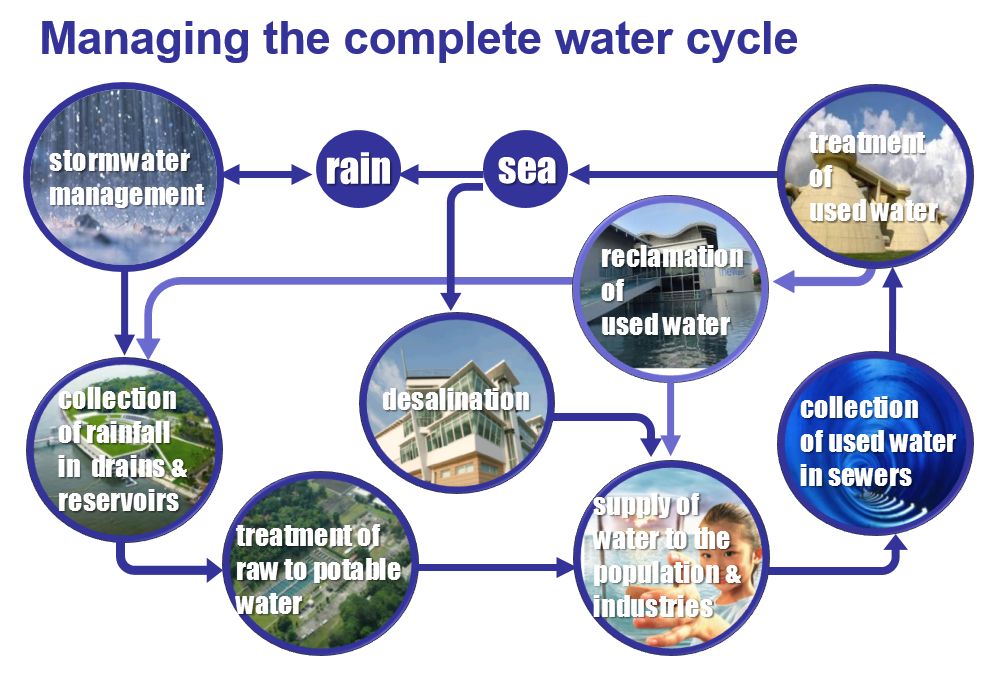
The following is an overview of the IWRM status in Singapore for five key water management issues pertinent to Singapore.
- Water Supply Management
The figure below shows the status of water supply management in Singapore for 2010 and 2013 for six key indicators.
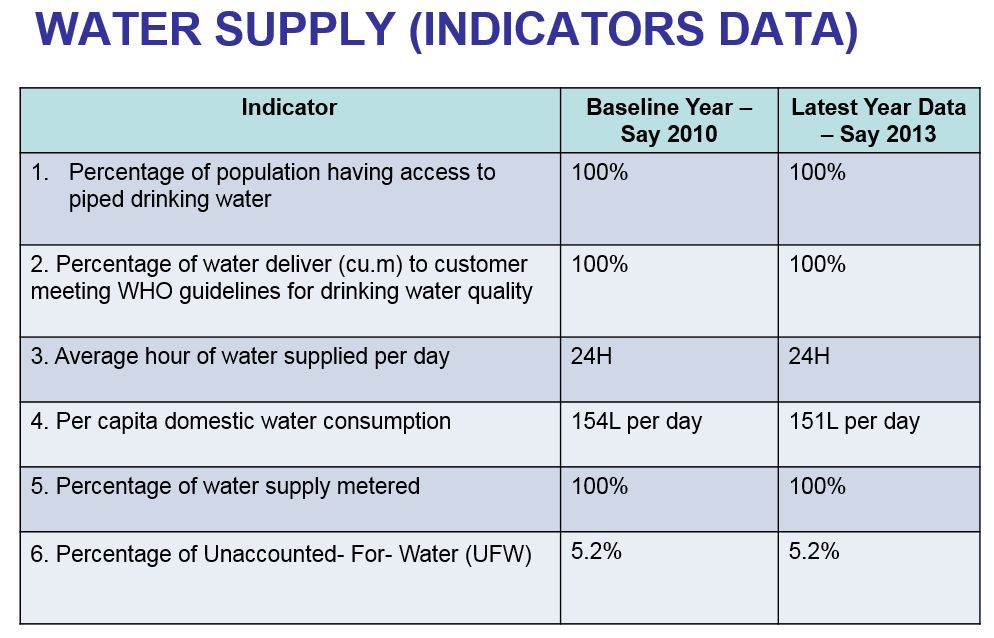
The key water supply management challenge is water demand management through Unaccounted-For Water (UFW) Control and Water Conservation as illustrated in the figure below.

To manage water demand effectively, a 2-pronged approach was adopted – by way of implementation of water conservation measures to keep potable water consumption in check and the other through the efficient management of the transmission and distribution system from water source to the customer tap to minimise the unaccounted-for water (UFW). Singapore’s water conservation strategy in curbing water demand growth takes a multi-pronged approach. This comprehensive approach targeting both domestic and non-domestic customers encompasses pricing, mandatory water conservation requirements and promoting and encouraging ownership and voluntarism through 3P (People, Private, Public) partnership in water conservation.
The following are the two key water conservation initiatives implemented in Singapore for the domestic and non-domestic sectors.
- 10-litre Challenge (Domestic Sector)
- Mandatory Water Efficiency Labelling Scheme
- Dual flush low capacity flushing cisterns
- Minimum Water Efficiency Standards
- Water Efficient Homes Programme
- Water Conservation Awareness Programme
- 10 % Challenge (Non Domestic Sector)
- Water Efficient Building Certification (Basic/ Silver/ Gold)
- Water Efficiency Manager Course
- Water Efficiency Fund
- Spore Standards 577 : 2012 Water Efficiency Management Systems
- Mandatory submission of Water Efficiency Management Plans
- Stormwater Management
The figure below shows the status of stormwater management in Singapore for 2010 and 2013 for six key indicators.
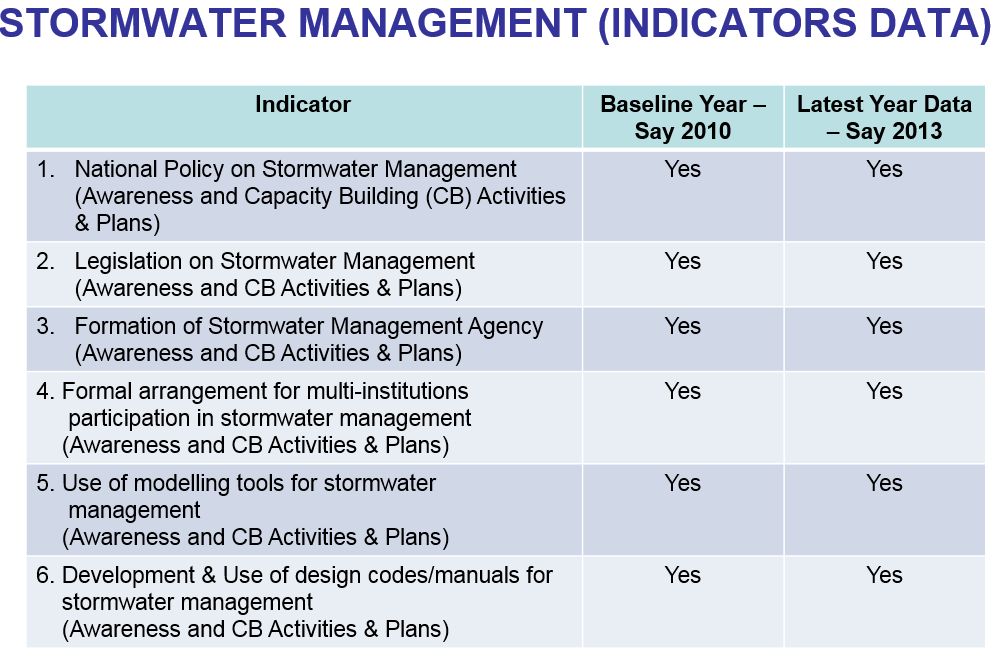
The figure below shows the progress and issues in stormwater management in Singapore.
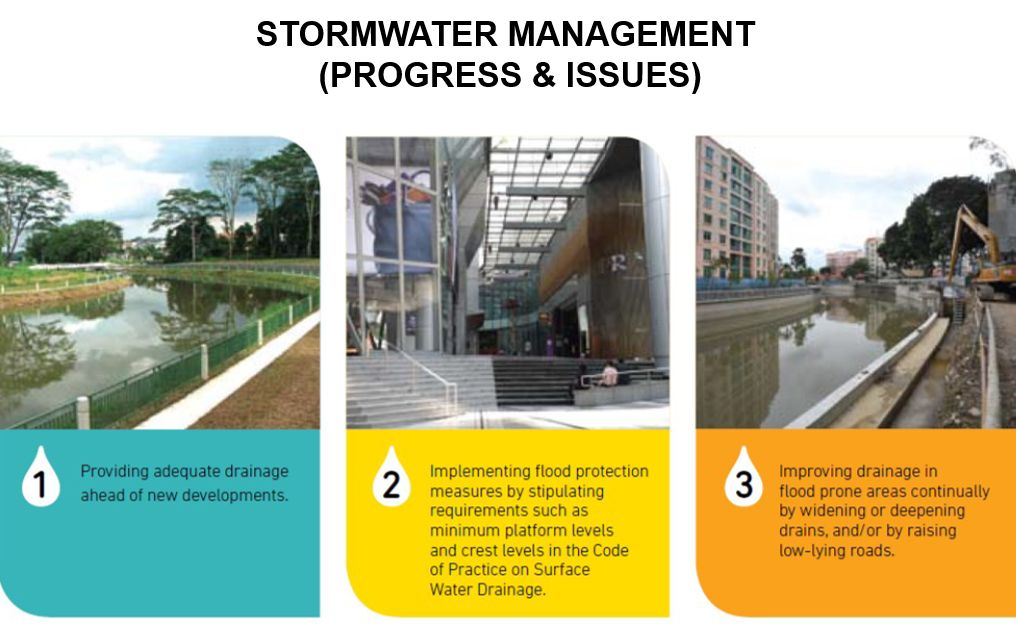
- Flood Management
The figure below shows the status of flood management in Singapore for 2010 and 2013 for nine key indicators.

The figure below shows the progress and issues in flood management in Singapore.
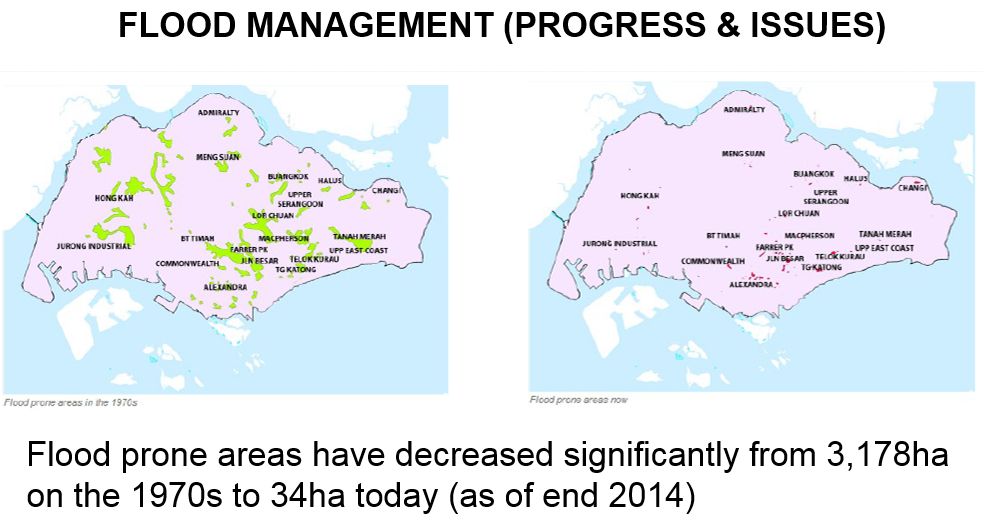
- Water Pollution Management
The figure below shows the status of water pollution management in Singapore for 2010 and 2013 for nine key indicators.
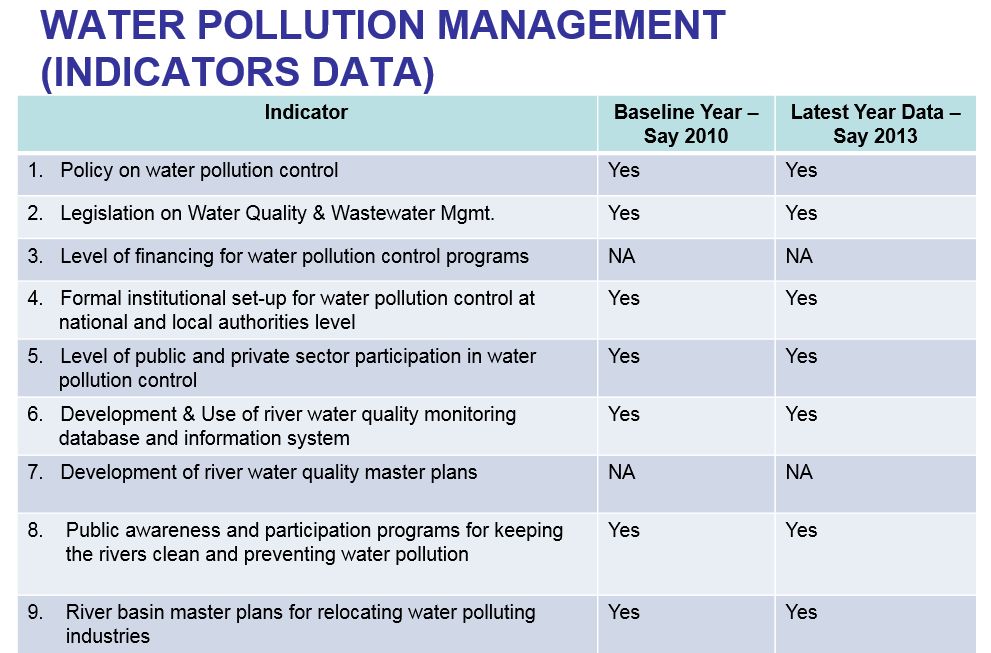
Singapore has also embarked on a programme called the Active, Beautiful and Clean (ABC) Waters Programme as illustrated in the figure below. Singapore has an extensive network of reservoirs and waterways comprising 32 major rivers and waterways, 14 reservoirs and 7,000 km of canals and drains. Under this programme, utilitarian concrete drains and canals are transformed into beautiful and vibrant community spaces for recreational activities so as to foster greater environmental ownership. This will in turn enhance the overall quality of life for Singaporeans, as the city continues to grow and develop.

Singapore also encourages its people to value and enjoy its waters (see figure below), such as the use of our reservoirs for activities such as kayaking and dragon boating. Under a waterways adoption programme, called the Our Waters programme, organizations and community groups can adopt stretches of water and pledge to take care of the water resources by conducting clean ups, river patrols and promote greater awareness of water among the community.

- Sanitation Management
The figure below shows the status of water sanitation management in Singapore for 2010 and 2013 for nine key indicators.
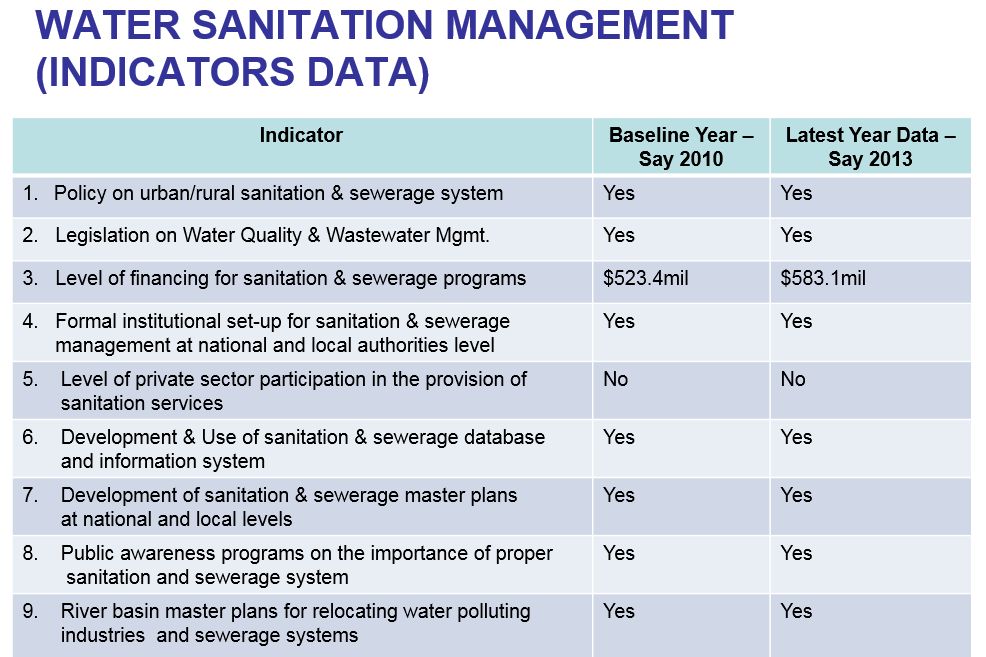
The figure below shows the sewerage infrastructure development in Singapore. Singapore’s Public Utilities Board (PUB) maintains 3460 km of sewers and 90,600 manholes, 48 km of deep sewer tunnels, 114 km of pumping mains, 81 pumping installations and 146 sewage treatment plants.
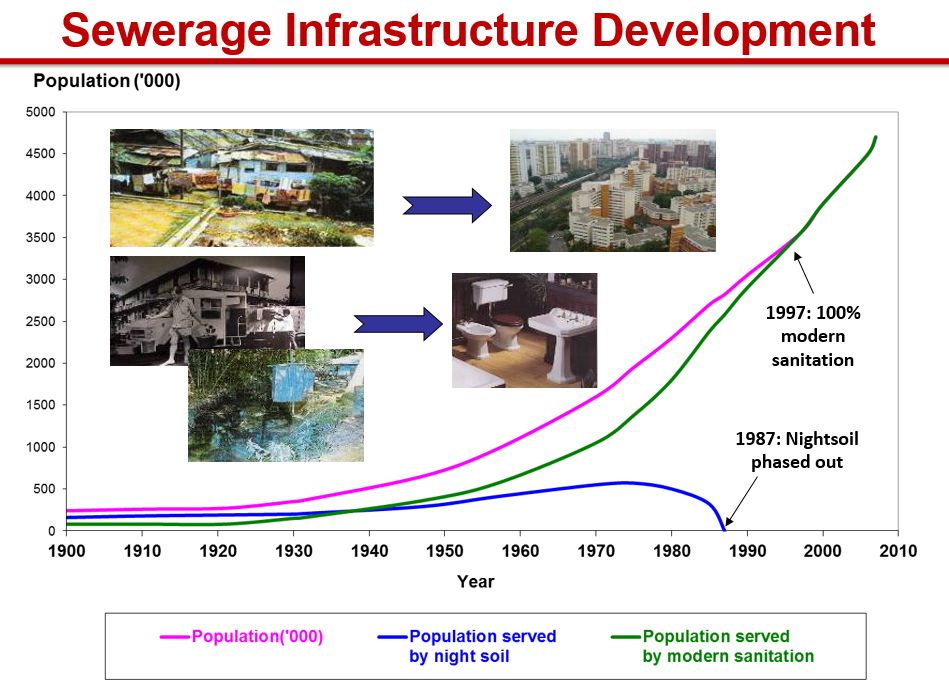
The figure below shows the extent of the deep tunnel sewerage system in Singapore, which stretches from one end of the island to the other.
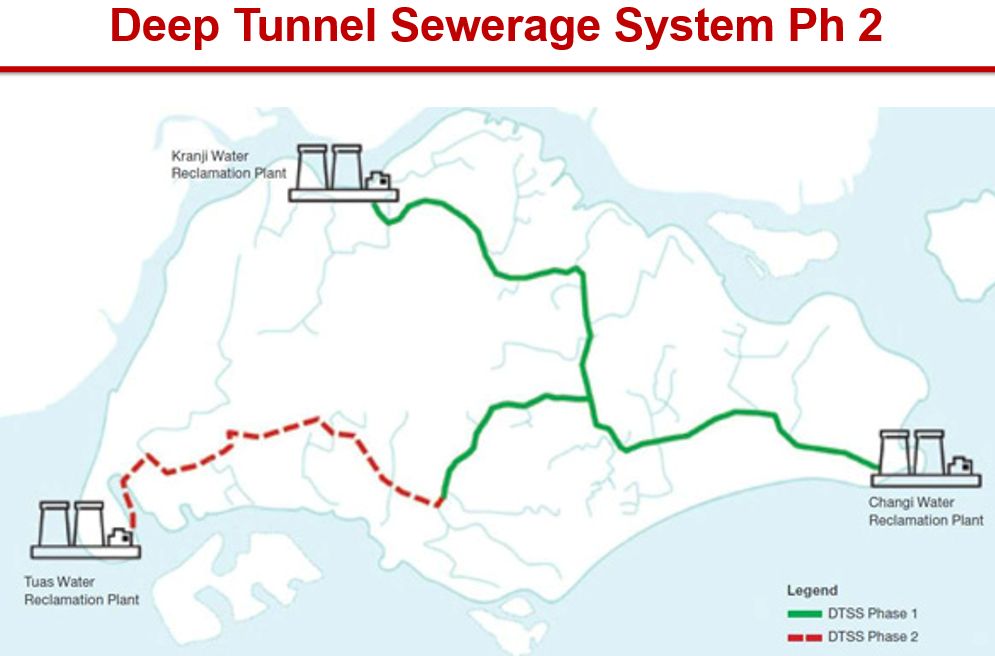
The figure below illustrates the public awareness activities carried out in Singapore to encourage Singaporeans to conserve, value and enjoy their waters.

 The following is an overview of the IWRM status in Singapore for five key water management issues pertinent to Singapore.
The following is an overview of the IWRM status in Singapore for five key water management issues pertinent to Singapore.
 The key water supply management challenge is water demand management through Unaccounted-For Water (UFW) Control and Water Conservation as illustrated in the figure below.
The key water supply management challenge is water demand management through Unaccounted-For Water (UFW) Control and Water Conservation as illustrated in the figure below.
 To manage water demand effectively, a 2-pronged approach was adopted – by way of implementation of water conservation measures to keep potable water consumption in check and the other through the efficient management of the transmission and distribution system from water source to the customer tap to minimise the unaccounted-for water (UFW). Singapore’s water conservation strategy in curbing water demand growth takes a multi-pronged approach. This comprehensive approach targeting both domestic and non-domestic customers encompasses pricing, mandatory water conservation requirements and promoting and encouraging ownership and voluntarism through 3P (People, Private, Public) partnership in water conservation.
The following are the two key water conservation initiatives implemented in Singapore for the domestic and non-domestic sectors.
To manage water demand effectively, a 2-pronged approach was adopted – by way of implementation of water conservation measures to keep potable water consumption in check and the other through the efficient management of the transmission and distribution system from water source to the customer tap to minimise the unaccounted-for water (UFW). Singapore’s water conservation strategy in curbing water demand growth takes a multi-pronged approach. This comprehensive approach targeting both domestic and non-domestic customers encompasses pricing, mandatory water conservation requirements and promoting and encouraging ownership and voluntarism through 3P (People, Private, Public) partnership in water conservation.
The following are the two key water conservation initiatives implemented in Singapore for the domestic and non-domestic sectors.
 The figure below shows the progress and issues in stormwater management in Singapore.
The figure below shows the progress and issues in stormwater management in Singapore.

 The figure below shows the progress and issues in flood management in Singapore.
The figure below shows the progress and issues in flood management in Singapore.

 Singapore has also embarked on a programme called the Active, Beautiful and Clean (ABC) Waters Programme as illustrated in the figure below. Singapore has an extensive network of reservoirs and waterways comprising 32 major rivers and waterways, 14 reservoirs and 7,000 km of canals and drains. Under this programme, utilitarian concrete drains and canals are transformed into beautiful and vibrant community spaces for recreational activities so as to foster greater environmental ownership. This will in turn enhance the overall quality of life for Singaporeans, as the city continues to grow and develop.
Singapore has also embarked on a programme called the Active, Beautiful and Clean (ABC) Waters Programme as illustrated in the figure below. Singapore has an extensive network of reservoirs and waterways comprising 32 major rivers and waterways, 14 reservoirs and 7,000 km of canals and drains. Under this programme, utilitarian concrete drains and canals are transformed into beautiful and vibrant community spaces for recreational activities so as to foster greater environmental ownership. This will in turn enhance the overall quality of life for Singaporeans, as the city continues to grow and develop.
 Singapore also encourages its people to value and enjoy its waters (see figure below), such as the use of our reservoirs for activities such as kayaking and dragon boating. Under a waterways adoption programme, called the Our Waters programme, organizations and community groups can adopt stretches of water and pledge to take care of the water resources by conducting clean ups, river patrols and promote greater awareness of water among the community.
Singapore also encourages its people to value and enjoy its waters (see figure below), such as the use of our reservoirs for activities such as kayaking and dragon boating. Under a waterways adoption programme, called the Our Waters programme, organizations and community groups can adopt stretches of water and pledge to take care of the water resources by conducting clean ups, river patrols and promote greater awareness of water among the community.

 The figure below shows the sewerage infrastructure development in Singapore. Singapore’s Public Utilities Board (PUB) maintains 3460 km of sewers and 90,600 manholes, 48 km of deep sewer tunnels, 114 km of pumping mains, 81 pumping installations and 146 sewage treatment plants.
The figure below shows the sewerage infrastructure development in Singapore. Singapore’s Public Utilities Board (PUB) maintains 3460 km of sewers and 90,600 manholes, 48 km of deep sewer tunnels, 114 km of pumping mains, 81 pumping installations and 146 sewage treatment plants.
 The figure below shows the extent of the deep tunnel sewerage system in Singapore, which stretches from one end of the island to the other.
The figure below shows the extent of the deep tunnel sewerage system in Singapore, which stretches from one end of the island to the other.
 The figure below illustrates the public awareness activities carried out in Singapore to encourage Singaporeans to conserve, value and enjoy their waters.
The figure below illustrates the public awareness activities carried out in Singapore to encourage Singaporeans to conserve, value and enjoy their waters.

